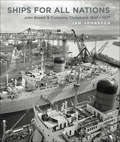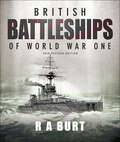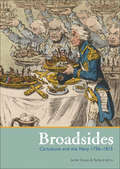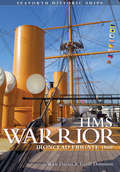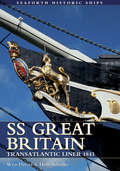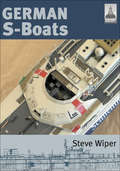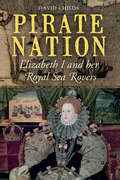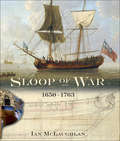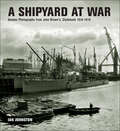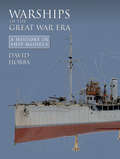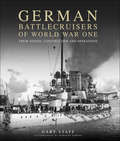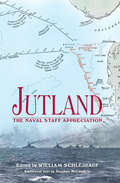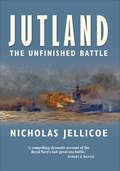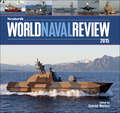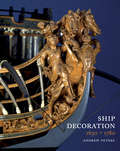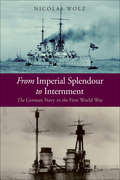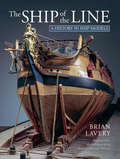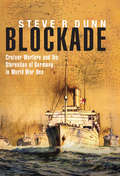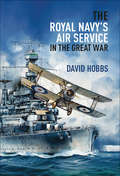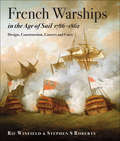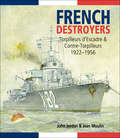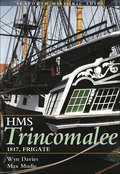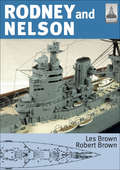- Table View
- List View
Ships for All Nations: John Brown & Company Clydebank, 1847–1971
by Ian Johnston&“A worthy tribute to the John Brown company and to British shipbuilding . . . a joy to enthusiasts of the great ships of the past.&”—Australian Naval Institute The Clydebank shipyard built some of the most famous vessels in maritime history—great transatlantic liners like Lusitania, Queen Mary and QE2, and iconic warships like the battlecruiser Hood, and Britain&’s last battleship, HMS Vanguard. Starting life as J & G Thomson in 1847, the business acquired its more famous persona when taken over in 1899 by the Sheffield-based steelmaker John Brown & Co, which enhanced the yard&’s existing reputation for turning out first-class products, both naval and mercantile. This book charts the fortunes of the company in terms of its business development, its management and personnel, as well as the great variety of ships it built during the century and a quarter of its existence. It also tells a wider story of the rise to world domination of the British shipbuilding industry and its eventual decline and collapse in the post-war decades, as reflected in the experience of John Brown. Written by an acknowledged authority on Clydeside shipbuilding, the book was originally published in a limited edition in 2000, but this reprint is entirely new and revised, although it retains all the original photographs from the yard&’s own unrivaled collection. &“Essential to anyone&’s maritime collection.&”—Sea Breezes &“The profusely illustrated, beautifully produced and very detailed story of John Brown & Company.&”—Army Rumour Service
British and Commonwealth Warship Camouflage of WWII: Destroyers, Frigates, Sloops, Escorts, Minesweepers, Submarines, Coastal Forces and Auxiliaries
by Malcolm George WrightDuring the Second World War navies developed low visibility camouflage for their ships, on both the vertical and horizontal surfaces, in order reduce visibility by blending in with the sea, or confuse the identity of a ship by applying more obtrusive patters. In this new book by maritime artist Mal Wright both the official and unofficial paint schemes that adorned ships of the Royal Navy and Commonwealth are depicted in detail, along with discussion on changes of armament and electronics that effected the outward appearance of each ship.Starting with destroyers from WW1 still in service during WW2, the book progressively covers ships below cruisers, class by class, to provide a detailed and easy-to-use guide to paint schemes in use. In some cases individual ships are shown in the several schemes they wore thus providing a source that covers various periods of service. With 740 full colour illustrations, all of named vessels, this book concentrates information into a single volume to provide a one-stop reference source, and, for the first time in a single volume, it covers not just the well-known ships, but also escort vessels, minesweepers, trawlers, coastal craft and auxiliaries in sequential format. Many schemes would be difficult for the reader to have found other than with the most intensive research so that historians, collectors, modelmakers and wargamers will find this unique reference source absolutely invaluable.
British Battleships of World War One: New Revised Edition
by R.A. BurtThe classic reference on the technical history of British capital ship design and construction during the dreadnought era. A century ago at Jutland, Dogger Bank, Heligoland Bight, and the first battle for the Falklands, mighty squadrons of these great armored ships fought their German counterparts for command of the seas. Beginning with Dreadnought, this book continues to the end of the First World War, and all of the fifty dreadnoughts, &“super-dreadnoughts,&” and battlecruisers that served the Royal Navy during this era are described and superbly illustrated with photographs and line drawings. Each class of ship is described in detail so that design origins, and technical and operational factors, are discussed alongside characteristics, with special emphasis on armament, armor, and machinery. Fully detailed data tables are included for every class, and more than 500 photographs and line drawings illustrate the text. A delight for the historian, enthusiast and ship modeler, this volume is regarded as an essential reference work for this most significant era in naval history and ship design.
Broadsides: Caricatures and the Navy, 1756–1815
by James DaveyBroadsides explores the political and cultural history of the Navy during the later eighteenth and early nineteenth centuries through contemporary caricature. This was a period of intense naval activity encompassing the Seven Years War, the American War of Independence, the wars against revolutionary and Napoleonic France, and the War of 1812.Naval caricatures were utilised by the press to comment on events, simultaneously reminding the British public of the immediacy of war, whilst satirising the same Navy it was meant to be supporting.The thematic narrative explores topics from politics to invasion, whilst encompassing detailed analysis of the context and content of individual prints. It explores pivotal figures within the Navy and the feelings and apprehensions of the people back home and their perception of the former. The text, like the cariactures themselves, balances humour with the more serious nature of the content. The emergence of this popular new form of graphic satire culminated in the works of James Gillray and Thomas Rowlandson, both here well represented, but a mass of other contemporary illustration makes this work a hugely important source book for those with any interest in the wars and history of this era.
HMS Warrior: Ironclad Frigate 1860 (Seaforth Historic Ships)
by Wyn Davies Geoff Dennison&“A well-illustrated tour of the ship as she is today, deck by deck . . . includes a historical introduction looking at the ship and her significance.&”—Ships Monthly HMS Warrior, launched in 1860, was the first iron-hulled, sea-going armored ship, and for many years was the most powerful warship in the world. Rescued a century later from her role as a refueling hulk, she became the object of the most ambitious ship restoration project ever mounted and is now afloat and open to visitors at Portsmouth. As is the case for many historic ships, however, there is a surprising shortage of informative and well-illustrated guides, for reference during a visit or for research by enthusiasts, ship modelers, naval buffs, technical historians or students. This book—second in the Seaforth Historic Ship Series—redresses the gap. Written by experts and containing more than 200 specially commissioned photographs, each title in the series takes the reader on a superbly illustrated tour of the ship, deck by deck. Significant parts of the vessel for example, the steering gear, armament and armor, engine-room and gundeck are given detailed coverage so that the reader has at hand the most complete visual record and explanation of the ship that is at present available. In addition, the importance of the ship, both in her own time and now as a museum vessel, is explained, while her design and build, her service career and her life prior to restoration and exhibition are all described. The Seaforth Historic Ship Series is a truly groundbreaking concept, bringing the ships of our past vividly to life. &“A beautiful publication.&”—Ships in Scale
SS Great Britain: Transatlantic Liner, 1843 (Seaforth Historic Ships)
by Wyn Davies Herb SchmitzThe SS Great Britain, designed by Isambard Brunel, was the first ocean-going vessel to be screw-driven and built entirely of iron. When she was launched in 1843 she was twice the size of any previous ship and her revolutionary design heralded a complete break with traditional ship construction. As is the case for many historic ships, however, there is a surprising shortage of informative and well illustrated guides, for reference during a visit or for research by enthusiasts - ship modellers, naval buffs, historians or students. This new series redresses the gap. Written by experts and containing more than 200 specially commissioned photographs, each title takes the reader on a superbly illustrated tour of the ship, from bow to stern and deck by deck. Significant parts of the vessel for example, the propeller, steering gear, engine and accommodation are given detailed coverage both in words and pictures, so that the reader has at hand the most complete visual record and explanation of the ship that exists. In addition, the importance of the ship, both in her own time and now as a museum vessel, is explained, while her design and build, and her career prior to restoration and exhibition are all described.No other books offer such superb visual impact and detailed information as the Seaforth Historic Ship Series a truly groundbreaking concept bringing the ships of our past vividly to life.
German S-Boats (ShipCraft)
by Steve WiperThe 'ShipCraft' series provides in-depth information about building and modifying model kits of famous warship types. Lavishly illustrated, each book takes the modeller through a brief history of the subject class, highlighting differences between sister-ships and changes in their appearance over their careers. This includes paint schemes and camouflage, featuring colour profiles and highly-detailed line drawings and scale plans. The modelling section reviews the strengths and weaknesses of available kits, lists commercial accessory sets for super-detailing of the ships, and provides hints on modifying and improving the basic kit. This is followed by an extensive photographic gallery of selected high-quality models in a variety of scales, and the book concludes with a section on research references—books, monographs, large-scale plans and relevant websites. The subject of this volume is the Second World War German Navy's motor torpedo boats called Schnellboote, known to the Allies as E-Boats. One of the most effective coastal attack craft of the time, the type was built in large numbers and constantly improved as the war progressed, giving many variants to interest modellers. With its unparalleled level of visual information—paint schemes, models, line drawings and photographs—it is simply the best reference for any modelmaker setting out to build one of these famous boats.
Pirate Nation: Elizabeth I and her Royal Sea Rovers
by David ChildsFor all the romantic mythology surrounding the court of Queen Elizabeth I, the financial underpinning of the reign of 'Gloriana' was decidedly sordid. Elizabeth's policy of seizing foreign assets made her popular at home but drew her into a public/private partnership with pirates who preyed on the state's foes and friends alike, being rewarded or punished depending on how much of a cut the Queen received, rather than the legitimacy of their action. For this reason the rule of law at sea was arbitrary, and almost non-existent. Even those, such as the Lord Admiral and the Court of Admiralty, who were tasked with policing the seas and eliminating piracy, managed their own pirate fleets. While honest merchants could rail and fail, the value to the exchequer of this dubious income was enormous, often equalling, on an annual basis, the input from all other sources such as taxation or customs dues.However, the practice of piracy taught English seamen how to fight and, when the nation was at its greatest peril, in 1588, it was pirates who kept the Armada away from the coast. Effingham, Grenville, Ralegh and Drake, became 'admirals all for England's sake', but this highly original book argues that their deeply ingrained piratical approach to naval warfare almost allowed the Armada to succeed. This is only one of a number of startling insights into the reality of Elizabethan naval policy offered by this honest and eminently readable reappraisal.
The Sloop of War, 1650–1763: 1650-1763
by Ian McLaughlan&“A delight . . . fulfills a long-felt need to do justice to the smaller ships of war that did such sterling service for the sailing Royal Navy.&”—Ships in Scale This is the first study in depth of the Royal Navy&’s vital, but largely ignored small craft. In the age of sail, they were built in huge numbers and in far greater variety than the more regulated major warships, so they present a particular challenge to any historian attempting a coherent design history. However, for the first time this book charts the development of the ancillary types, variously described in the 17th century as sloops, ketches, brigantines, advice boats and even yachts, as they coalesce into the single 18th-century category of Sloop of War. In this era, they were generally two-masted, although they set a bewildering variety of sail plans from them. The author traces their origins to open boats, like those carried by Basque whalers, shows how developments in Europe influenced English craft, and homes in on the relationship between rigs, hull-form and the duties they were designed to undertake. Visual documentation is scanty, but this book draws together a unique collection of rare and unseen images, coupled with the author&’s own reconstructions in line drawings and watercolor sketches to provide the most convincing depictions of the appearance of these vessels. By tackling some of the most obscure questions about the early history of small-boat rigs, the book adds a dimension that will be of interest to historians of coastal sail and practical yachtsmen, as well as warship enthusiasts. &“Fascinating . . . It combines a truly scholarly delivery with a lovely presentation. History brought to life.&”—tomcunliffe.com
A Shipyard at War: Unseen Photographs from John Brown's, Clydebank 1914–1918
by Ian JohnstonA treasury of photos illustrating the work of the famed British shipbuilders of World War I. Although best known for large liners and capital ships, between 1914 and 1920 the Clydebank shipyard of John Brown & Co. built a vast range of vessels—major warships down to destroyers and submarines, unusual designs like a seaplane carrier and submarine depot ship, and even a batch of war-standard merchant ships. This makes the yard a particularly good example of the wartime shipbuilding effort. Clydebank employed professional photographers to record the whole process of construction, using large plate cameras that produced pictures of stunning clarity and detail; but unlike most shipyard photography, Clydebank’s collection has survived, although relatively few of the images have ever been published. For this book, some two hundred of the most telling were carefully selected and scanned to the highest standards, depicting in unprecedented detail every aspect of the yard’s output, from the liner Aquitania in 1913 to the cruiser Enterprise, completed in 1920. Although ships are the main focus of the book, the photos also chronicle the impact of the war on working conditions in the yard—and the introduction of women in large numbers to the workforce. With lengthy and informative captions, and an authoritative introduction by Ian Johnston, this book is a vivid portrait of a lost industry at the height of its success.
Warships of the Great War Era: A History in Ship Models
by David HobbsThe National Maritime Museum in Greenwich houses the largest collection of scale ship models in the world, many of which are official, contemporary artefacts made by the craftsmen of the navy or the shipbuilders themselves, and ranging from the mid seventeenth century to the present day. As such they represent a three-dimensional archive of unique importance and authority. Treated as historical evidence, they offer more detail than even the best plans, and demonstrate exactly what the ships looked like in a way that even the finest marine painter could not achieve. This book is one of a series that takes a selection of the best models to tell the story of specific ship types in this case, the various classes of warship that fought in the First World War, from dreadnoughts to coastal motor boats. It reproduces a large number of model photos, all in full colour, and including many close-up and detail views. These are captioned in depth, but many are also annotated to focus attention on interesting or unusual features. Although pictorial in emphasis, the book weaves the pictures into an authoritative text, producing an unusual and attractive form of technical history.
German Battlecruisers of World War One: Their Design, Construction And Operations
by Gary StaffThis is the most comprehensive study yet in the English language of the German Imperial Navy's battlecruisers that served in the First World War. Known as Panzerkreuzer, literally 'armoured cruiser', the eight ships of the class were to be involved in several early North Sea skirmishes before the great pitched battle of Jutland where they inflicted devastating damage on the Royal Navy's battlecruiser fleet.In this new book the author details their design and construction, and traces the full service history of each ship, recounting their actions, largely from first-hand German sources and official documents, many previously unpublished in English. Detailed line drawings and maps augment the text throughout, as do a wealth of contemporary photos that depict the vessels at sea as well as in dock, where details of damage sustained in action and many aspects of their design can be viewed in close up. A superb series of full-colour, specially-commissioned computer graphics show full length profiles and top-down views of each ship in precise and clear detail. This stunning book is a major new contribution to German naval history in this country and will become a 'must-have' volume on the shelves of historians, enthusiasts and modellers and indeed for anyone interested in the navies of the First World War and steel warships in general.
Seaforth World Naval Review 2016
by Conrad Waters&“The crème de la crème of naval writers . . . an extremely detailed overview of the last year in naval policy, construction and deployment.&”—Warship World This annual has an established reputation as an authoritative but affordable summary of all that has happened in the naval world in the previous twelve months. It combines regional surveys with one-off major articles on noteworthy new ships and other important developments. Besides the latest warship projects, it also looks at wider issues of importance to navies, such as aviation and electronics, and calls on expertise from around the globe to give a balanced picture of what is going on and to interpret its significance. This edition looks in detail at the Royal Navy as it faces the latest defense review, and evaluates the Indonesian Navy, while significant ships will include the USN&’s San Antonio class amphibious transports, the new Dutch OPVs, the Turkish Milgem class corvettes and the Greek Roussen class fast attack craft. There are also technological reviews dealing with naval aviation by David Hobbs, focusing on maritime patrol aircraft, while Norman Friedman surveys recent electronic warfare developments. Intended to make interesting reading as well as providing authoritative reference, there is a strong visual emphasis, including specially commissioned drawings and the most up-to-date photographs and artists&’ impressions. For anyone with an interest in contemporary naval affairs, whether an enthusiast or a defense professional, this annual has become required reading. &“A high-quality, deeply-researched and handsomely-illustrated book.&”—Army Rumour Service
Jutland: The Naval Staff Appreciation
by William SchleihaufThe legendary hidden report on the Royal Navy&’s failures at the WWI Battle of Jutland is revealed for the first time in this transcribed edition. Jutland, the largest naval battle of the First World War, was the most controversial engagement in the Royal Navy&’s history. Falling well short of the total victory expected by the public, it sparked fierce debate among senior naval officers, many of whom had been directly involved in the battle. The first attempt to produce an objective record was delayed and heavily censored. That report was followed by a no-holds-barred critique of the fleet&’s performance intended for training purposes at the Naval Staff College. This became the now-infamous Naval Staff Appreciation, which was deemed too damaging to be published. All proof copies were ordered destroyed. Despite the orders, however, a few copies survived. Now this long-suppressed work is finally revealed in this edition featuring expert modern commentary and explanatory notes.
Jutland: The Unfinished Battle
by Nicholas JellicoeThis book not only re-tells the story of the battle from both a British and German perspective based on the latest research, but it also helps clarify the context of Germanys inevitable naval clash. It then traces the bitter dispute that ensued in the years after the smoke of war had cleared right up to his death in 1935, Admiral Jellicoe was embroiled in what became known as the Jutland Controversy.
Seaforth World Naval Review 2015: 2015
by Conrad WatersThe &“profusely illustrated&” yearly military reference that features world fleet reviews, significant ship developments, and technological advancements (Ships Monthly). Now in its seventh year, this annual has established an international reputation as an authoritative but affordable summary of all that has happened in the naval world in the previous twelve months. It combines regional surveys with one-off major articles on noteworthy new ships and other important developments. Besides the latest warship projects, it also looks at wider issues of importance to navies, such as aviation and electronics, and calls on expertise from around the globe to give a balanced picture of what is going on and to interpret its significance. The 2015 edition looks in detail at the French Navy and the Bangladesh and Myanmar navies, while significant ships include the Montford Point class mobile landing platforms, the Samuel Beckett offshore patrol vessels, and the Skjold class fast attack craft. There are technological reviews dealing with naval aviation by David Hobbs, and current mine warfare developments by Norman Friedman, while warship recycling is discussed by Ian Buxton. Intended to make interesting reading as well as providing authoritative reference, there is a strong visual emphasis, including specially commissioned drawings and the most up-to-date photographs and artists&’ impressions. For anyone with an interest in contemporary naval affairs, whether an enthusiast or a defense professional, this annual has become required reading.
Ship Decoration, 1630–1780: 1630-1780
by Andrew PetersThis book is a detailed comparative study of the decorative work figurehead, topside ornamentation and stern gallery design carried by the ships of the major maritime states of Europe in the zenith of the sailing era. It covers both warships and the most prestigious merchant ships, the East Indiamen of the great chartered companies. The work began life in the year 2000 when the author was commissioned to carry out research for an ambitious project to build a full-size replica of a Swedish East Indiaman, which produced a corpus of information whose relevance stretched way beyond the immediate requirements of accurately decorating the replica.In tracking the artistic influences on European ship decoration, it became clear that this was essentially the story of the baroque style, its dissemination from France, and its gradual transformation into distinct national variations in Britain, the Netherlands, Denmark and Sweden. It is an inherently visual subject and the book illustrates developments with numerous photographs of contemporary ship models, paintings and plans, as well as the author's own interpretive illustrations of details.As the first major work on the topic for nearly a century, it will be of obvious appeal to ship modellers and historians, but with comparative examples drawn from architecture and sculpture, it also makes a broader contribution to the history of the applied arts.
From Imperial Splendour to Internment: The German Navy in the First World War
by Nicolas WolzThis important new work describes how the Imperial German Navy, which had expanded to become one of the great maritime forces in the world, second only to the Royal Navy, proved, with the exception of its submarines, to be largely ineffective throughout the years of conflict.The impact of this impotence had a far-reaching effect upon the service. Germany, indeed most of Europe, was in the grips of a spirit of militant nationalistic fervour, and the inactivity of the great Imperial Navy caused deep frustration, particularly among the naval officers. Not only were they unable to see themselves as heroes, they were also ridiculed on the home front and felt profoundly humiliated. With the exception of the one sea battle at Jutland, their ships saw little or no action at sea and morale slowly collapsed to a point where, at the end of the war, the crews were in a state of mutiny. The seemingly ludicrous order that forced the fleet to go to sea against the British in 1918 was driven by a sense of humiliation, but coming at the war's end it triggered a revolution because the German sailors wanted no part in such madness. The internment at Scapa Flow was the ultimate shaming. This is a fascinating and perceptive analysis of a whole era, and it contributes substantially to our understanding of the war and its consequences consequences, sadly, that helped pave the way for the Third Reich.
The Ship of the Line: A History in Ship Models (A\history In Ship Models Ser.)
by Brian Lavery&“A beautiful book . . . a goldmine of information to anyone interested in the capital ships of the sailing navy of the 17th and 19th Centuries.&”—Ships in Scale The National Maritime Museum in Greenwich houses the largest collection of scale ship models in the world, many of which are official, contemporary artifacts made by the craftsmen of the navy or the shipbuilders themselves, and ranging from the mid-seventeenth century to the present day. As such they represent a three-dimensional archive of unique importance and authority. Treated as historical evidence, they offer more detail than even the best plans, and demonstrate exactly what the ships looked like in a way that even the finest marine painter could not achieve. The Ship of the Line is the second of a new series that takes selections of the best models to tell the story of specific ship types—in this case, the evolution of the ship of the line, the capital ship of its day, and the epitome of British seapower during its heyday from 1650-1850. This period also coincided with the golden age of ship modelling. Each volume depicts a wide range of models, all shown in full color, including many close-up and detail views. These are captioned in depth, but many are also annotated to focus attention on interesting or unusual features, and the book weaves the pictures into an authoritative text, producing a unique form of technical history. The series is of particular interest to ship modellers, but all those with an enthusiasm for the ship design and development in the sailing era will attracted to the in-depth analysis of these beautifully presented books.
Blockade: Cruiser Warfare and the Starvation of Germany in World War One
by Steve R DunnThis WWI naval history vividly tells the story of the Royal Navy&’s Northern Blockade and the battles at sea that brought Germany to its knees. At the outbreak of World War I, Britain established a naval blockade that greatly diminished Germany&’s access to trade and vital resources. The Northern Blockade brought the German economy to its knees and greatly diminished home front morale. Patrolling the inhospitable waters between Iceland and Scotland, the 10th Cruiser Squadron played a vital role in winning the war on the Western Front. At the same time, the Royal Navy successfully countered Germany&’s attacks on British commerce, preventing much suffering in Britain. Drawing on numerous first-hand accounts, Historian Steve Dunn vividly chronicles this long-running battle at sea. Beginning with the blockade&’s initial formation, he recounts the changes in strategy on both sides, including the use of converted liners and armed merchant vessels as warships. He also vividly describes the final destruction of German surface vessel commerce warfare, culminating in the hard-fought battle between the raider SMS Leopard and two British warships.
The Royal Navy's Air Service in the Great War
by David HobbsIn a few short years after 1914 the Royal Navy practically invented naval air warfare, not only producing the first effective aircraft carriers, but also pioneering most of the techniques and tactics that made naval air power a reality. By 1918 the RN was so far ahead of other navies that a US Navy observer sent to study the British use of aircraft at sea concluded that any discussion of the subject must first consider their methods. Indeed, by the time the war ended the RN was training for a carrier-borne attack by torpedo-bombers on the German fleet in its bases over two decades before the first successful employment of this tactic, against the Italians at Taranto.Following two previously well-received histories of British naval aviation, David Hobbs here turns his attention to the operational and technical achievements of the Royal Naval Air Service, both at sea and ashore, from 1914 to 1918. Detailed explanations of operations, the technology that underpinned them and the people who carried them out bring into sharp focus a revolutionary period of development that changed naval warfare forever. Controversially, the RNAS was subsumed into the newly created Royal Air Force in 1918, so as the centenary of its extinction approaches, this book is a timely reminder of its true significance.
French Warships in the Age of Sail, 1786–1861: Design, Construction, Careers and Fates
by Rif Winfield Stephen S RobertsIn 1786 the French Navy had just emerged from its most successful war of the eighteenth century, having frequently outfought or outmanoeuvred the Royal Navy in battle, and made a major contribution to American independence. The reputation of its ship design and fighting skills never stood higher, yet within a few years the effects of the French Revolution had devastated its efficiency, leading to defeat after defeat. Fine ships continued to be built, but even under Napoleon's dynamic influence the navy never recovered sufficiently to alter the balance of sea power. It was only after 1815 that the navy revived, espousing technical innovation and invention, to produce some of the most advanced ships of the age.This book is the first comprehensive listing of these ships in English, and follows the pattern set by the companion series on British warships in the age of sail in providing an impressive depth of information. It is organised by Rate, classification and class, with significant technical and building data, followed by a concise summary of the careers of each ship in every class. Thus for the first time it is possible to form a clear picture of the overall development of French warships in the latter half of the sailing era.
French Destroyers: Torpilleurs d'Escadre & Contre-Torpilleurs, 1922–1956
by John Jordan Jean Moulin&“A superb book that will keep any reader happy for months as they discover stories and episodes in French naval destroyer design and history.&”—Warship World Between the wars the French produced some of the largest, and certainly the fastest, destroyers in the world. Known as Contre-Torpilleurs, these striking and innovatory super-destroyers form the core of this book, but the more conventional Torpilleurs d&’Escadre are also covered. This history combines the technical and service material published in French-language monographs over the past two decades with the authors&’ own research from primary sources. The structure of the book follows that of the highly successful French Cruisers, with Part I devoted to the design of each of the classes built after 1922. The text is accompanied by detailed data tables and illustrated by a comprehensive set of specially drawn plans and schemas based on official documents, as well as carefully selected photographs from French naval sources and from private collections. Coverage runs down to the Le Hardi class, the last pre-war design. Part II deals with the historical side, covering the eventful careers of these ships before, during and after the war. This section is illustrated by maps specially drawn for the book, and by contemporary photographs. Like its highly successful predecessors, French Battleships and French Cruisers, this beautifully presented book &“fills a significant gap in the English library about French warships. Apart from that the book will absolutely be a treasure on the bookshelves of collectors, historians, ships modelers and all other devotees of maritime history&” (Go2War2.nl).
HMS Trincomalee: 1817, Frigate (Seaforth Historic Ships)
by Max Mudie Wyn DaviesHMS Trincomalee belonged to a class of 38-gun Fifth Rates which can claim to have been the Royal navy's standard frigate type for the whole of the Napoleonic Wars. Built in India of teak, she is now beautifully restored at Hartlepool, and can justly claim to be the last of Nelson's frigates. As is the case for many historic ships, however, there is a surprising shortage of informative and well illustrated guides, for reference during a visit or for research by enthusiasts—ship modellers, naval buffs, historians or students. This new series redresses the gap. Written by experts and containing more than 200 specially commissioned photographs, each title takes the reader on a superbly illustrated tour of the ship, from bow to stern and deck by deck. Significant parts of the vessel for example, the gun decks, her mast, spars and rigging, and her aft accommodation are given detailed coverage both in words and pictures, so that the reader has at hand the most complete visual record and explanation of the ship that exists. In addition, the importance of the ship, both in her own time and now as a museum vessel, is explained, while her design and build, and her career prior to restoration and exhibition are all described.No other books offer such superb visual impact and detailed information as the Seaforth Historic Ship Series a truly groundbreaking concept bringing the ships of our past vividly to life.
Rodney and Nelson (ShipCraft #23)
by Robert Brown Les Brown&“Simply the best reference for any model maker&” on the most instantly recognizable British battleships in history (Warship World). The ShipCraft series provides in-depth information about building and modifying model kits of famous warship types. Lavishly illustrated, each book takes the modeler through a brief history of the subject class, highlighting differences between sisterships and changes in their appearance over their careers. This includes paint schemes and camouflage, featuring color profiles and highly detailed line drawings and scale plans. The modeling section reviews the strengths and weaknesses of available kits, lists commercial accessory sets for super-detailing of the ships, and provides hints on modifying and improving the basic kit. This is followed by an extensive photographic survey of selected high-quality models in a variety of scales, and the book concludes with a section on research references—books, monographs, large-scale plans and relevant websites. The two ships covered in this volume were the only capital ships designed and built between the wars—a special concession of the Washington Treaty&’s ban on new battleships—and they were unlike anything before them, with the superstructure three-quarters aft and all main armament turrets forward of the bridge. During the war, Nelson survived mine and torpedo damage, while Rodney played a major part in the destruction of the Bismarck, both surviving to be broken up post-war.
